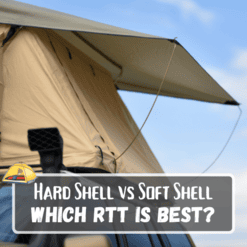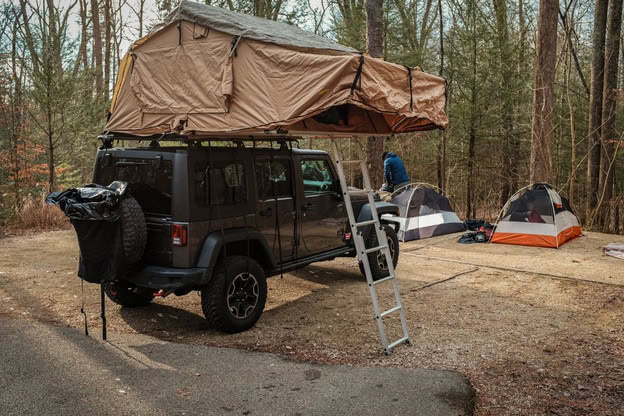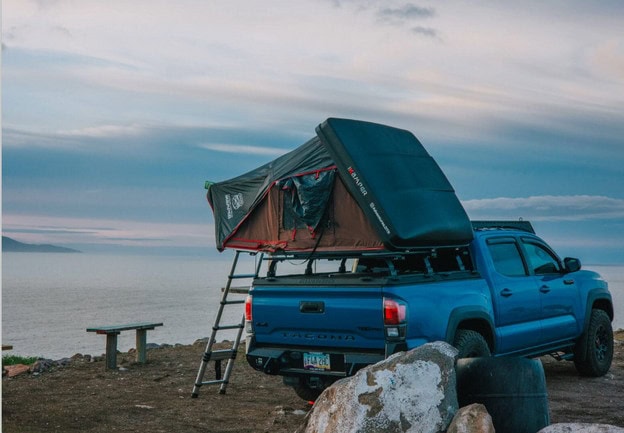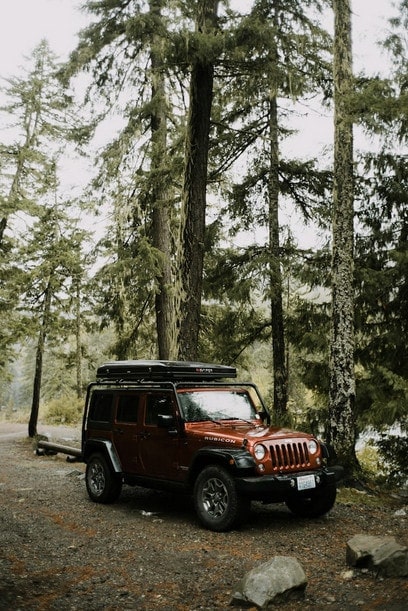
If you’re looking at rooftop tents (RTTs), you’ve probably noticed that there are two main types—hard shell and soft shell.
Soft shell rooftop tents tend to be more affordable and have more livable space, but also typically come with a less durable tent fabric and don’t hold up as long.
Hard shell roof tents are typically much more expensive, but come with added durability, weather resistance, and easier setup.
In this article, we will go over the pros and cons of each type of roof top tent so you can make an informed buying decision. Let’s dive in!
Soft Shell Rooftop Tent Pros & Cons
Soft shell roof top tents have been around for decades—they’re tried and true and, depending on your camping needs, might be a better choice for than hard shell tents.
Pros
Soft Shell Tents Are Cheaper
While both types of RTTs cost more than a traditional ground tent, soft shell tents are significantly less expensive than their hard shell counterparts.
The cost of soft shell roof tents can vary from $1000-$3900, depending on the size and brand, but even the pricier ones are more affordable than hard shell tents—a huge plus if you’re on a budget.
Related Reading: What is a Rooftop Tent & How Do They Work?
Often Provide a Bigger Living Space
Because they fold out towards the sides of your vehicle rather than pop straight up, soft shell tents aren’t limited to the footprint of your car’s roof. This creates more living space than ost hard shell tents.
The extra interior space is key if you want to take the whole family camping.

Photo by Brian Erickson on Unsplash
Smaller Footprint
Soft shell tents offer more sleeping space when they are set up, yet still maintain a smaller footprint when folded down.
These tents can pack down a lot—some to almost half the size they are when folded out, so you have more roof space to haul toys or extra gear.
Cons
Takes Longer to Set Up & Take Down
That soft shell tent isn’t going to set itself up! The protective cover, poles, and extra material require a lot more time and effort than hard shell tents to fold out and take down.
You can always practice setting up a few times before heading out into the wilderness, but you should consider the weather conditions you’re usually in—rain, snow, or wind can make this exponentially harder.
Don’t Have As Much Protection From The Elements
Soft shell roof top tents are made from softer materials which makes them susceptible to tears, leaks, and wind. They lack a hard shell made from plastic or fiberglass to offer protection from weather.
You can always add a rain cover or waterproof coating to it, but they’re not as durable as hard shell tents.
More Noise in the Wind
We’ve already established that soft shell roof tents are made from softer, lighter materials which means more moving parts.
Many soft shell tents also have a rain cover similar to a regular tent, all that fabric is bound to flap around on a windy night—which may or may not drive you crazy.

Photo by Jorgen Hendriksen on Unsplash
Hard Shell Rooftop Tent Pros & Cons
Hard shell roof top tents are newer to the market than soft shell models but they have quickly become popular among avid campers.
They are constructed from stronger materials than soft shell tents and have a ton of great benefits, but there are some downsides when considering a hard shell roof tent.
Pros
More Aerodynamic
Most hard shell roof top tents are designed to be aerodynamic on top of your car. They pack down nearly flat which creates less drag so your gas mileage won’t suffer as much.
This is a great perk to hard shell tents especially if your adventures take you far from home.
Much Easier to Set Up & Take Down
One of the biggest advantages of a hard shell roof top tent is how quickly they can be set up and taken down.
Hard shell roof tents pop up into place in less than a minute—all you have to do is undo a few latches and guide the tent until the built-in gas struts take over the rest of the way.
Taking it down requires a bit more effort but still not as much as soft shell models. In some hard shell tents, there’s even enough room to leave your sleeping bag inside when it’s folded down.

More Weatherproof
Like we mentioned before, the hard plastic or fiberglass outer shell of a hard shell tent offers more protection from the elements than a shell made of fabric.
The protective shell makes these tents almost impermeable even in inclement weather and there’s much less flapping in the wind.
Typically More Comfortable Mattress
The built-in mattress in hard shell tents don’t have to be folded over onto themselves, so they’re usually thicker than those in a soft shell tent.
You can trust that those extra few inches of foam make a big difference in your comfortability while camping.
Related: The Best Camping Mattresses to Upgrade Your Tent
Cons
Less Living Space
Hard shell tents can either pop straight up into four vertical walls or diagonally into a wedge shape. This doesn’t allow for a lot of usable space or head room.
They also usually only comfortably sleep 1-2 people, but if your camping crew is small, the more comfortable mattress might make up for the smaller space.

Photo by Blake Carpenter on Unsplash
Significantly More Expensive
The most glaring con of a hard shell tent is the price tag.
They’re constructed from more durable and heavy materials than soft shell tents which contributes to the higher price.
It might be difficult, but not impossible to find a hard shell tent within your budget. Depending on your camping habits, it could still be a worthwhile investment.
So Should You Get a Hard Shell or Soft Shell Tent?
Everyone’s rooftop tent needs are subjective and it’s clear that both soft shell and hard shell tents have a lot to offer.
For the casual camper or a family camping trip, soft shell tents are easier on your wallet, have more space, and a smaller footprint.
On the other hand, it’s clear that hard shell rooftop tents have more pros than cons. Their aerodynamic construction, quick set up, durable hard shells, and thick mattress make them the top contender for tent owners.
Whichever kind of roof top tent you decide to get, you’ll be more comfortable and have an easier time setting up camp than you had with any ground tent.
Read Next: